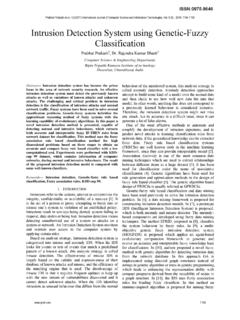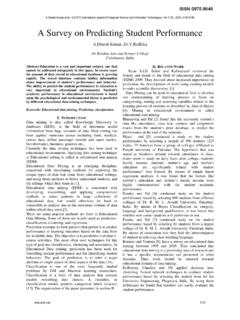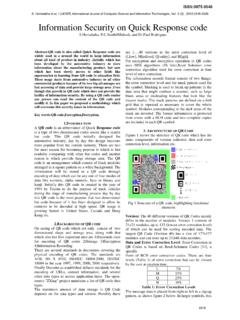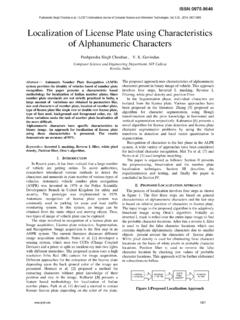Transcription of EEG Based Emotion Recognition System - IJCSIT
1 EEG Based Emotion Recognition System Prashant Lahane#1, Shrutika Lokannavar*2, Apurva Gangurde*3, Poonam Bhosale*4, Pooja Chidre*5 #Computer Department, MIT College Of Engineering Pune, India *Computer Department, Savitribai Phule Pune University Pune, India Abstract In this paper we have shown Emotion Recognition through EEG processing. Based on the literature work, we have made the best selection of the techniques available so far. This paper is easy to perceive, understand, and interpret the proposed method and the techniques like signal pre-processing, feature extraction and, signal classification in BCI. Our aim in this paper is to come up with an efficient and reliable Emotion Recognition System . Keywords Computer-Interface, Signal Processing, Feature Extraction, EEG signals. I. INTRODUCTION In the past, bio signals have been used for many purposes besides the conventional uses of clinical diagnosis and cognitive neuroscience.
2 The project aims at Emotion Recognition through EEG signals. The objective of the project is signal pre-processing, feature extraction and classification which will provide the emotional state. Signal Pre-processing: Signal pre-processing is also known as Signal Enhancement. The first thing we need is some raw EEG data to process. The acquired brain signals are contaminated by noise and artifacts (unwanted signals). Removal of these artifacts and noise is nothing but Pre-processing. Feature Extraction: Once the signal is pre-processed, essential features from these signals are extracted in this process. Classification: Using machine learning techniques, we can train a classifier to recognize from among our features which ones belong to which emotional states. II. Emotion Recognition As we know emotions play an important role in day to day life of human beings, the need and importance of Emotion Recognition has grown with increasing role of Brain Computer Interface (BCI).
3 Emotion Recognition could be done from audio-visual Based methods like speech, facial expression or body gestures. But these methodologies do not provide an efficient and appropriate output. As compared with audio-visual Based methods, the responses of bio signals tend to provide more detailed and complex information for determining emotional states. A. Electroencephalography(EEG) The project concentrates on Recognition of emotions from electroencephalogram (EEG) signals. The EEG is composed of electrical potentials arising from several sources. The ongoing brain activity recorded using EEG provides noninvasive measurement. EEG appears to be the less intrusive and the one with the best time resolution than the other three (MEG, fMRI) techniques. EEG signals captured from the brain in central nervous System (CNS) have been proved to provide informative characteristics in responses to the emotional states.
4 The work is presented for making a System which is able to detect human Emotion through brain signals. Many experiments have been performed till now by just Chopping analyzed EEG signals and using neural networks to classify six emotions Based on emotional valence and arousal. But these results have only 64 percent success rate. Our System aims to achieve 100 percent success rate. EEG- Based technologies were initially used only in medical applications like epilepsy and seizures. Since availability of new wireless headsets that are portable, price effective and easy to use are available in the market. It expands the possibility to spread the technology to the areas such as entertainment, e-learning, virtual worlds, etc. Automatic Emotion detection from EEG signals is receiving more attention with the development of new forms of human-computer interaction with digital media.
5 The goal is to perform real-time Emotion classification using automatic machine learning algorithms. III. RELATED WORK(LITERATURE REVIEW) Emotion Recognition from EEG Using Higher Order Crossings( Panagiotis C. Petrantonakis): In this System , a novel Emotion Recognition and EEG- Based feature extraction technique is presented. This work includes higher order crossings (HOC) analysis, employed for the feature extraction scheme and a robust classification method, namely HOC- Emotion classifier (HOC-EC), was implemented testing four different classifiers [quadratic discriminant analysis (QDA), k-nearest neighbor, Mahalanobis distance, and support vector machines (SVMs)], in order to accomplish efficient Emotion Recognition . Prashant Lahane et al, / ( IJCSIT ) International Journal of Computer Science and Information Technologies, Vol.
6 5 (6) , 2014, Recognition from facial Expressions using Multilevel HMM( Ira Cohen, Ashutosh Garg, Thomas S. Huang. Beckman) This work focuses on automatic facial expression Recognition from live video input using temporal cues. Methods for using temporal information have been extensively explored for speech Recognition applications. Among these methods is template matching using dynamic programming methods and hidden Markov models (HMM). The novelty of this architecture is that both segmentation and Recognition of the facial expressions are done automatically using a multilevel HMM architecture while increasing the discrimination power between the different classes. This System explores person-dependent and person-independent Recognition of expressions. EEG- Based Emotion Recognition in Music Listening(Yuan-Pin Lin, Chi-Hong Wang, Tzyy-Ping Jung): This work have made use of machine learning algorithm to categorize emotional state of a person during music listening.
7 Classifier used to is SVM(support vector machine) and MLP with classification accuracy 82%.A machine-learning approach to classify four music induced emotional states is proposed and tested in this study, which might provide a different viewpoint and new insights into music listening and Emotion responses[1]. IV. RESEARCH GAPS FROM EXISTING WORK Higher order crossings (HOC) analysis used HOC- Emotion classifier (HOC-EC), which was implemented testing four different classifiers [quadratic discriminant analysis (QDA), k-nearest neighbor, Mahalanobis distance, and support vector machines (SVMs)], in order to accomplish efficient Emotion Recognition . This technique was efficient but as it required four classifier the computation time increased and complexity too. This System provides 100% accuracy only for four expressions if the no of expression is increased; its efficiency reduces to 62%.
8 In Hidden Markov Models, a larger database is needed for the training, and possibly the subjects should be classified according to some categories, such as ethnic background and gender. The tests also showed that some emotions are greatly confused as against others (anger, disgust, sadness and fear).The main drawback in all of the works done on Emotion Recognition from facial expression videos is the lack of a benchmark database to test different algorithms. Recognizing the Emotion from just the facial expressions is probably not accurate enough. To overcome the drawbacks of the previous work, we have tried to come up with a more efficient System , which is 100% accurate for all types of emotions . Our System uses best technique for pre-processing, extraction and classification and as we have made use of single technique in each step of Emotion Recognition , the computational time is reduced and complexity also.
9 V. OBJECTIVES AND CONTRIBUTIONS Objectives and contributions in proposed System are: To recognize emotions using efficient techniques. To get the emotions without flaws. To overcome difficulties in previous System . VI. PROPOSED WORK The work is presented for making a System which is able to detect human Emotion through brain signals. Many experiments have been performed till now by just Chopping analyzed EEG signals and using neural networks to classify six emotions Based on emotional valence and arousal [9].But these results have only 64 percent success rate. Our System aims to achieve 100 percent success rate. Our method will have the same conventional flow as shown in figure 1. In this paper, we have used techniques which are computationally easy and gives accurate results EEG RAW DATA emotions Fig.
10 1. Architecture of Proposed System .. A. Independent Component Analysis (ICA) It is a statistical procedure used for splitting up a set of mixed signals into its sources .ICA considers that the observed EEG signal is a mixture of several source signals coming from multiple activities. ICA therefore expresses the resulting EEG signal x (t) in relation to their sources s(t) as: The resulting EEG signal is as: x (t) = f(s(t)) + n(t) Where, f=any unknown mixer function n (t) = an additive random noise vector s (t) = source of signal x (t) = output vector The dimension of output vector x (t) is equal to the number of measured data channels. The whole ICA problem consists in the calculation of the unmixing function by inverting f and obtaining an estimation of s (t), by mapping x (t) to the source space. ICA is divided into two different models Based on f.










